Fission Track Laboratory
- Home
- Instruments and Personnel
- Methods and Applications
- Project and Scientific Interests
- Pubblications

Fission-track analysis is an important tool in low-temperature thermochronology to understand rates and timings of a range of shallow to mid-crustal processes. It is currently apply to assess tectonic hazards, landscape development, tectonic geomorphology, dating processes of mountain building, hydrocarbon exploration, basin sedimentary burial history, and much more.
Fission tracks are linear damage tracks that occur in minerals that are caused by the spontaneous fission of heavy, unstable nuclides (mostly 238U in natural minerals). They are thermally unstable. For a given time and temperature they will partially or even totally disappear (track annealing) due to restoration of the crystal lattice. An apatite fission-track age is, in this respect, a cooling age. It yields the time when the mineral cooled down to a temperature at which the FTs became stable. Thermal annealing is reflected by a shortening of the track length. By Combining age determination and track length measurements information on mineral thermal history can be gathered. For apatite, computer models have been developed to reconstruct thermal histories.
AT IGG-CNR fission-track lab both apatite and zircon minerals are analyzed. We also select, measure and prepare apatites for (U-Th)/He analyses.
INSTRUMENTS
For track counting and measuring, a Zeiss Axioskop microscope equipped with transmitted and reflected light and a Kinetek automatic stage and carrying a drawing tube attachment overlooking a high resolution digitising tablet, is used. FT stage 4.0 software developed by Trevor Dumitru for counting and measuring tracks and Dpars is used. For thermal history modelling the HeFTy and QT-Qt programs are used.
In addition, housed within the fission track lab is an Olympus SZ61 stereo microscope, used primarily for grain selection for (U-Th)/He analyses. Attached to this scope (and also interchangeable with the Zeiss scope) is a digital camera allowing images to be captured and stored in a computer.
Complete Fission Track dating facilities are available at IGG-CNR. We have a mineral separation lab for concentrating apatite and zircon, facilities for mounting, polishing and etching the samples.
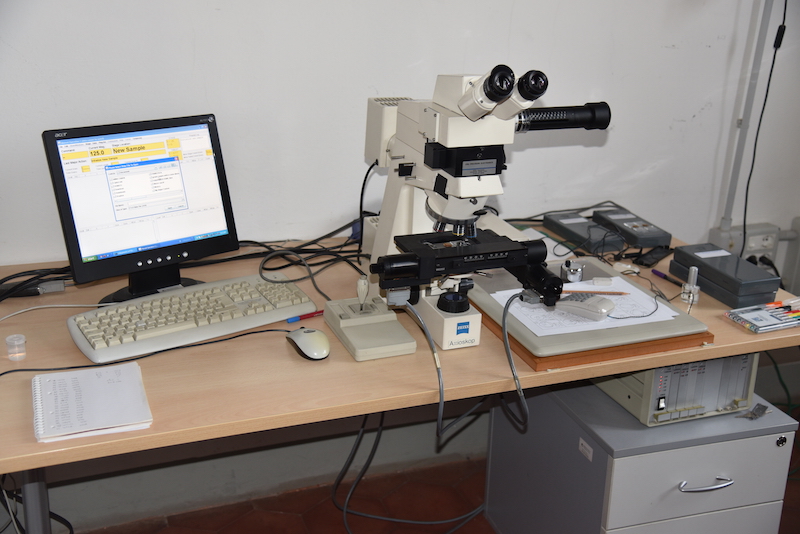
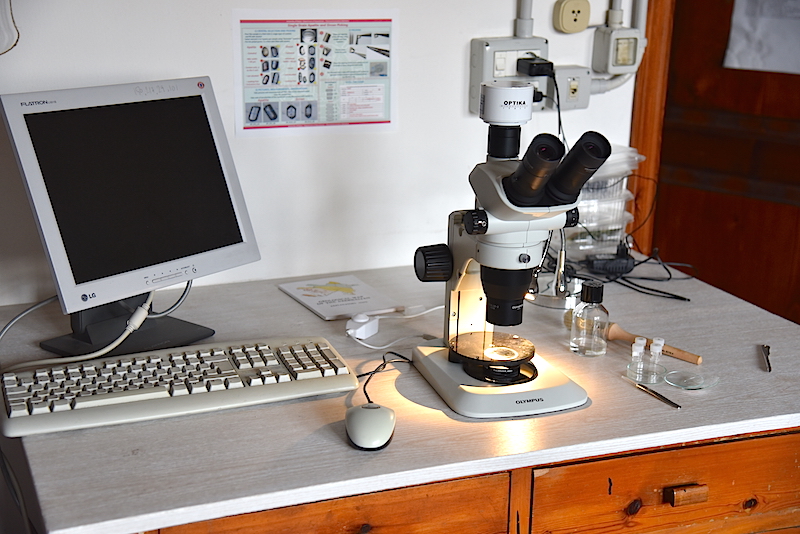
Fission tracks are linear damage tracks that occur in minerals that are caused by the spontaneous fission of heavy, unstable nuclides (mostly 238U in natural minerals). The spontaneous fission of 238U occurs at a given rate, described by the decay constant. This means that when the uranium concentration of a sample is known, the spontaneous FT density (ρs = number of tracks/cm2) in that sample is an indication for the sample’s age. ρs is determined by counting the tracks under an optical microscope (at 1250 x magnification). Uranium content is measured by irradiating the sample in a nuclear reactor with thermal neutrons. These neutrons induce fission of 235U isotopes in the sample. The induced FT density (ρi) provides a measure for the 235U concentration. Because in nature the 235U /238U ratio is a constant, the Uranium content can be derived and the age of the sample can be calculated. For irradiation, IGG Fission-track laboratory uses the Triga Mark II reactor of the LENA, University of Pavia.
PROJECTS
NDuring the past ten years the IGG fission-track lab was involved in several scientific national projects funded by MIUR and Programma Nazionale di Ricerche in Antartide. In 2008 was involved in the3 year EUROCORES project THERMOEUROPE: Coupled climatic/tectonic forcing of European topography revealed through thermochronometry.
MAIN SCIENTIFIC INTERESTS
Geodynamic and tectonic evolution of extensional (Nubia margin, Ethiopian Rift, Transantartic Mountains) and convergent settings (Alps, Northern Apennines, Eastern Sicily thrust belt) through application of low-temperature thermochronological techniques. These methods allow quantifying exhumation and denudation rates through time and space, offering clues to geomorphic evolution and constraints for a better understanding of the climate-tectonics feedbacks.
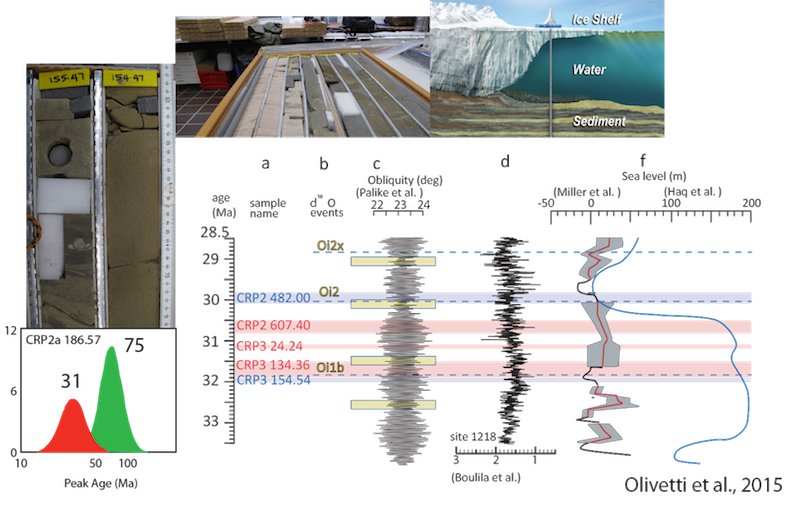
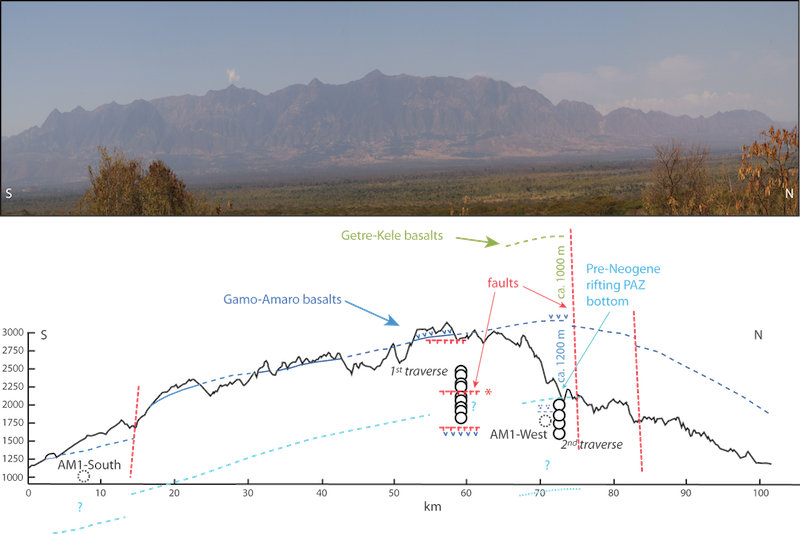
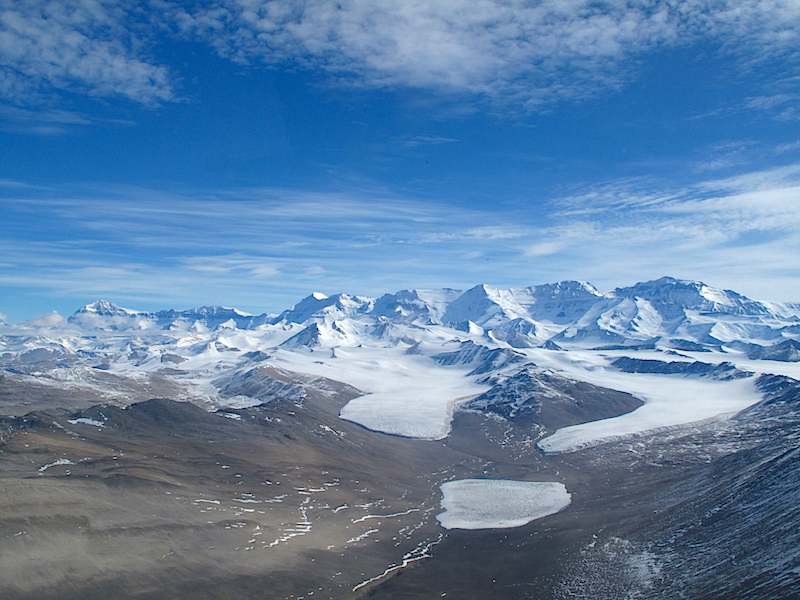
A detrital fission-track study on apatites from the drill-cored stratigraphic succession of the Cape Roberts Project (McMurdo sound, Victoria Land Basin, Antarctica). Identification of an age peak composed by far-travelled apatites with a young (< 40 Ma) age.
- Olivetti V., Balestrieri M.L., Rossetti F., Thomson S., Talarico F.M., Zattin M. (2015). Evidence of a full West Antarctic Ice Sheet back to the early Oligocene: insight from double dating of detrital apatites in Ross Sea sediments. Terra Nova, 27, 238–246.
- Remitti F., Balestrieri M.L., Bettelli G., Vannucchi P. (2013). Early exhumation of underthrust units near the toe of an ancient erosive subduction zone: A case study from the Northern Apennines of Italy. GSA Bullettin, 125, 1820-1832.
- Olivetti V., Balestrieri M.L., Rossetti F., Talarico F.M. (2013). Tectonic and climatic signals from apatite detrital fission-track analysis of the Cape Robert Project core records, south Victoria Land, Antarctica. Tectonophysics, 594, 80–90.
- Balestrieri M.L., Benvenuti M., Tangocci, F. (2013). Detrital fission-track-compositional signature of an orogenic chain-hinterland basin system: The case of the late Neogene Quaternary Valdelsa basin (Northern Apennines, Italy). Sedimentary Geology, 289, 159–168.
- Vignaroli G., Minelli L., Rossetti F., Balestrieri M.L., Faccenna C. (2012). Miocene thrusting in the eastern Sila Massif: Implication for the evolution of the Calabria-Peloritani orogenic wedge (southern Italy). Tectonophysics, 538–540, 105–119. doi:10.1016/j.tecto.2012.03.011
- Malusà M.G. and Balestrieri M.L. (2012). Burial and exhumation across the Alps–Apennines junction zone constrained by fission-track analysis on modern river sands. Terra Nova, 24, 221-226.
- Balestrieri M.L. , Bigazzi G., Pandeli E., Bigazzi G., Carosi R., Montomoli C. (2011). Age and temperature constraints on metamorphism and exhumation of the syn-orogenic metamorphic complexes of Northern Apennines, Italy. Tectonophysics, 509, 254-271.
- Folco L., Bigazzi G., D’Orazio M., Balestrieri M.L. (2011). Fission track age of Transantarctic Mountain microtektites. Geochimica et Cosmochimica Acta, 75, 2356-2360.
- Abebe T., Balestrieri M.L., Bigazzi G., (2010). The Central Main Ethiopian Rift younger than 8 Ma: confirmation through Apatite fission-track thermochronology. Terra Nova, 22, 470-476. doi: 10.1111/j.1365-3121.2010.00968.x.
- Olivetti V., Balestrieri M.L., Faccenna C., Stuart F. M., Vignaroli G. (2010). Middle Miocene out-of-sequence thrusting and successive exhumation in the Peloritani Mts, Sicily: late stage evolution of an orogen unraveled by apatite fission-track and (U-Th)/He thermochronometry. Tectonics, accepted. Tectonics, 29, TC5005, doi:10.1029/2009TC002659.
- Thomson S. N., Brandon M.T., Reiners P.W., Zattin M., Isaacson P.J., Balestrieri M.L., (2010). Thermochronologic evidence for orogen-parallel variability in wedge kinematics during extending convergent orogenesis of the northern Apennines, Italy, Geological Society of America Bulletin 2010;122;1160-1179; doi: 10.1130/B26573.1
- Corrado S., Aldega L., Balestrieri M.L., Maniscalco R., Grasso M. (2009). Structural evolution of the sedimentary accretionary wedge of the alpine system in Eastern Sicily: thermal and thermochronological constraints. Geological Society of America Bulletin, 121, 1475-1490. doi:10.1130/B26420.1
- Ketcham R. A., Donelick R.A., Balestrieri M.L., Zattin M. (2009). Reproducibility of apatite fission-track length data and thermal history reconstruction. Earth and Planetary Science Letters, 284, 504-515. doi: 10.1016/j.epsl.2009.05.015.
- Bernet M., Brandon M., Garver J., Balestrieri M.L., Ventura B., Zattin M. (2009). Exhuming the Alps through time: Clues from detrital zircon fission-track thermochronology. Basin Research, 21, 781-798. doi: 10.1111/j.1365-2117.2009.00400.x
- Balestrieri M.L., Abbate E., Bigazzi G. and Omer (2009). Thermochronological data from Sudan in the frame of the denudational history of the Nubian Red Sea margin. Earth Surface Processes and Landforms, 34, 9, 1279-1290.
- Balestrieri M.L., Moratti G., Bigazzi G. and Algouti A. (2009). Neogene exhumation of the Marrakech High Atlas (Morocco) recorded by apatite fission-track analysis. Terra nova, 21,75-82, doi: 10.1111/j.1365-3121.2008.00857.x.
- Storti F., Balestrieri M.L., Balsamo F., and Rossetti F. (2008). Structural and thermochronological constraints to the evolution of the West Antarctic Rift System in central Victoria Land. Tectonics, 27, TC4012, doi:10.1029/2006TC002066.
- Balestrieri M.L., Stuart F.M., Persano C., Abbate E. and Bigazzi G. (2005). Geomorphic developmentof the escarpment of the Eritrean margin, southern Red sea, from combined apatite fission-track and (U-Th)/He thermochronometry. Earth and Planetary Science Letters, 231, 97-110.
- Bigazzi G., Balestrieri M.L., Norelli P. and Oddone M. (2004). Fission-track dating of a tephra layer in the Alat Formation of the Dandero Group (Danakil Depression, Eritrea). Rivista Italiana di Paleontologia e Stratigrafia, 110, 3-4.
- Abbate E., Balestrieri M.L., and Bigazzi G. (2002). Morphostructural development of the Eritrean rift flank (southern Red Sea) inferred from apatite fission-track analysis. Journal of Geophysical Research, 107, B11,doi: 10.1029/2001JB001009, pp.1-12.